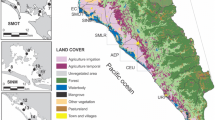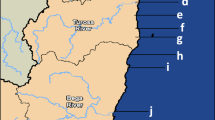Abstract
In 1995, preliminary water and sediment analyses of the river bed and burrow sediments from 9 locations along the Mooi River, NW Province, South Africa had shown cadmium concentrations up to 0.009 mg l−1±0.003 and up to 0.33 and 0.89 weight % with scanning electron microscopy (SEM) and x-ray microanalysis. Samples of the adult river crab (Potamonautes warreni) were collected from the Mooi River at Noordbrug (26°40′S/27°05′E), 1 km north of Potchefstroom Town, and exposed to 0.2 or 2.0 mg Cd2+ l−1 in situ to determine tolerance, uptake and bioaccumulation of cadmium. Using flame atomic absorption spectroscopy (FAAS) the gills, haemolymph and digestive gland of naturally exposed P. warreni showed wet mass values of 0.74±0.27 μg Cd2+ g−1, 0.007±0.007 μg ml−1 and 0.12±0.09 μg g−1 respectively. The tolerance of crabs to aqueous Cd reached its limit (ET50=42 hours) at 2.0 mg l−1 aqueous Cd exposure. At an exposure to 0.2 mg Cd2+ l−1 for 21 days, the greatest Cd (n=11; 9.99±5.09 μg g−1 wet mass) and Cu concentrations (n=11; 17.90±4.66 μg g−1 wet mass) were associated with the gills, and to a lesser extent the digestive gland (n=11; 0.38±0.20 μg g−1 wet mass), whereas concentrations of Zn were variable in both organs. In the haemolymph Cd levels were relatively small (n=11; 0.012–0.006 μg ml−1) with exposure and time and Cu, Zn concentrations varied. Changes in the uptake of Cd in P. warreni indicated that transport, storage and possibly regulatory mechanisms are likely to operate in adult crabs. The potential of P. warreni as a bioindicator species of pollution is also discussed.
Similar content being viewed by others
References
Atrill, M.J. and Depledge, M.H. (1997). Community and population indicators of ecosystem health: Targeting links between levels of biological organization. Aquatic Toxicol. 38, 183–97.
Bebianno, M.J. and Langston, W.J. (1993). Turnover rate of metallothionein and cadmium in Mytilus edulis. BioMetals 6, 239–44.
Bellilli, A., Zolla, L., Giardina, B., Costantini, S., Cau, A. and Brunori, M. (1985). Hemocyanin from Palinurus elephas: General properties and effects of heavy metals. Biochimica et Biophysica Acta 830, 325–31.
Bjerregaard, P. (19820). Accumulation of cadmium and selenium and their mutual interaction in the shore crab Carcinus maenas (L.). Aquatic Toxicol. 2, 113–25.
Brouwer, M. Bonaventura, C. and Bonaventura, J. (1982). Heavy metal ion interactions with Callinectes sapidus hemocyanin: Structural and functional changes induced by a variety of heavy metal ions. Biochem. 21, 2529–38.
Department of Water Affairs (1986). Management of the Water Resources of the Republic of South Africa. Cape Town: CTP Book Printers.
Depledge, M.H. (1984). Disruption of circulatory and respiratory activity in shore crabs (Carcinus maenas (L.)) exposed to heavy metal pollution. Comp. Biochem. Physiol. 78, 445–59.
Depledge, M.H. (1989). Re-evaluation of metabolic requirements for copper and zinc in decapod crustaceans. Mar. Environ. Res. 27, 115–26.
Depledge, M.H. and Billinghurst, Z. (1999). Ecological significance of endocrine disruption in marine invertebrates. Mar. Poll. Bull. 39(1–12), 32–8.
Depledge, M.H. and Rainbow, P.S. (1990). Models of regulation and accumulation of trace metals on marine invertebrates. Comp. Biochem. Physiol. 97C(1), 1–7.
Depledge, M.H., Weeks, J.M. and Bjerregaard, P. (1994). Heavy metals. In P. Calow. (ed) Handbook of Ecotoxicology, pp. 79–105. Cambridge: Blackwell Publishers.
Engel, D.W. and Brouwer, M. (1987). Metal regulation and moulting in the blue crab: Callinectes sapidus: Metallothionein function in metal metabolism. Biol. Bull. 173, 239–51.
Everaarts, J.M., Den Besten, P.J., Hillebrand, M.Th., Halbrook, R.S. and Shugart, L.R. (1998). DNA strand breaks, cytochrome P-450-dependant monooxygenase system activity and levels of chlorinated biphenyl congeners in the pyloric caeca of the seastar (Asterias rubens) from the North Sea. Ecotoxicol. 7, 69–79.
Gray, J.S., Clarke, K.R., Warwick, R.M. and Hobbs, G. (1990). Detection of initial effects of pollution on marine benthos: An example from the Ekofisk and Eldfisk oilfields, North Sea. Mar. Ecol. Prog. Ser. 66, 285–99.
Hinton D.E., Swee, J.T. and Adams, S.M. (19950). Histopathological indicators of fish health. 4th International Conference on Aquatic Ecosystem Health. 14–18 May 1995, Coimbra.
Klerks, P.L. and Weis, J.S. (1987). Genetic adaptation to heavy metals in aquatic organisms: A review. Environ. Poll. 45, 173–205.
Kneip, T.J. and Hazen, R.E. (1979). Deposit and mobility of cadmium in a marsh-cove ecosystem and the relation to cadmium concentration in biota. Environ. Health Perspect. 28, 67–73.
Lewis, J.W., Kay, A.N. and Hanna, N.S. (1994). Responses of electric fish Family Mormyridae to chemical changes in water quality. III Heavy metals. Environ. Technol. 15, 969–78.
Lyon R., Taylor, M. and Simkiss, K. (1984). Ligand activity in the clearance of metals from the blood of the crayfish ( Austropotamobius pallipes). J. Exp. Biol. 113, 19–27.
Morris, S. and van Aardt, W.J. (1998). Salt and water relations, and nitrogen excretion in the amphibious fresh water crab, Potamonautes warreni, with respect to emersion. J. Exp. Biol. 201(6), 883–93.
QSRNS Quality Status Report on the North Sea (1987). Report of the scientific and technical working group. UK: HSMO, Dep. Environ.
Radhakrishnaiah, K., Surish, A. and Sivaramakrishna, B. (1991). Size and sex related study on cadmium accumulation in different organs of the fresh water field crab, Oziotelphusa senex senex (Fabricius). Proc. Ind. Natn. Sci. Acad. 57B, 347–52.
Sandheinrich, M.B. and Atchinson, G.J. (1990). Sublethal toxicant effects on fish foraging behaviour; empirical vs. mechanistic approaches. Environ. Tox. Chem. 9, 107–19.
Schuwerack, P.-M.M., Lewis, J.W. Hoole, D. and Morley, N. in press. Ammonia-induced cellular and immunological changes in juvenile Cyprinus carpio infected with the blood fluke Sanguinicola inermis. Parasitology.
Steenkamp, V.E. (1992). The bioaccumulation of selected heavy metals in the crab, Potamonautes warreni, from industrial and mine polluted fresh water ecosystems, MSc dissertation. Republic of South Africa: Rand Afrikaans University.
Steenkamp, V.E., Du Preez, H.H. and Schoonbee, H.J. (1994). Bioaccumulation of copper in the tissues of Potamonautes warreni Calman Crustacea, Decapoda, Branchiura, from industrial, mine and sewage-polluted fresh water ecosystems. S. Afr. J. Zool. 29, 152–61.
Stigliani, W.M. and Jaffe, P.R. (1993). Industrial Metabolism and River Basin Studies: A New Approach for the Analysis of Chemical Pollution. Laxenburg, Austria: The International Institute for Applied Systems Analysis IIASA.
Sullivan, J.K. (1977). Effects of salinity and temperature on the acute toxicity of cadmium to the estuarine crab Paragrapsus gaimardii Milne Edwards. Aust. J. Mar. Freshwater Res. 28, 739–43.
Warwick, R.M. (1986). A new method for detecting pollution effects on marine macrobenthic communities. Mar. Biol. 92, 557–62.
Warwick, R.M. (1993). Environmental impact studies on marine communities: Pragmatical considerations. Austral. J. Ecol. 18, 63–80.
Wright, D.A. (1977). The effect of salinity on cadmium uptake by the tissue of the shore crab, Carcinus maenas (L.). The relationship with copper and other divalent ions. J. Exp. Biol. 67, 147–61.
Wright, D.A. and Brewer, C.C. (1979). Cadmium turnover in the shore crab Carcinus maenas. Mar. Biol. 50, 151–6.
Author information
Authors and Affiliations
Rights and permissions
About this article
Cite this article
Schuwerack, PM.M., Lewis, J.W. & Jones, P. The Potential Use of the South African River Crab, Potamonautes warreni, as a Bioindicator Species for Heavy Metal Contamination. Ecotoxicology 10, 159–166 (2001). https://doi.org/10.1023/A:1016689810391
Issue Date:
DOI: https://doi.org/10.1023/A:1016689810391




